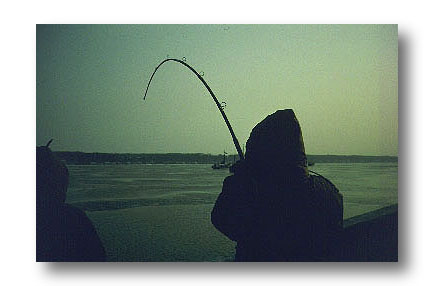|
The pattern is the same as for most other
salmonoid fishes. The female starts by digging a spawning pit
where the bottom and current are suitable. She then lies on her
side, and with powerful strokes of her tail she removes sand
and gravel until bare stone is revealed. Here she then spawns,
the male fertilises the roe and the female covers it.

- Winter fishing for cod
is definitely cold but can often be very productive.
- © photo: Steen
Ulnits
Hot breeding in fast water
During the breeding session, the males
in particular are very aggressive. They are very protective of
their territories, and often fight bitterly over the most attractive
females. Their strong colours send out powerful signals to rivals,
and the sturdy hook is often used for biting rivals' tails.
So salmon is a Jekyll and Hyde of a fish.
In the sea, it is has a very social disposition, but during its
migration upstream to reach the spawning grounds, it turns into
a regular monster, both in appearance and behaviour.
The internal struggles and the breeding
take their toll on the strength of the adult fish, and many of
them die after spawning. It is expected that about 90% of all
salmon die here, a percentage that varies from one stream to
another. It is possible to find salmo
The mortality rate of trout is a lot lower,
so many fish undergo spawning several times - unless they end
up in a monofilament gill net on their way to spawning
After breeding, the surviving salmon and
sea trout move out to sea again - now as lean "kelts".
In mild winters, the fish may be out again around the turn of
the year. In cold winters. it may take months before they dare
move into the salty waters again.
Slow fishing in cold waters
Eels are not very fond of cold water and
dig themselves down into the muddy bottom for the winter. It
is now completely impossible to get in touch with them as they
eat nothing at all.
The fish of the lakes also seek out deep
water, where they aim to spend the winter in the warmest conditions
possible. At its deepest point, lake water is always at 4 degrees
- whether the lake is covered by ice or not.
But unlike the eels, it is still possible
to catch them out here provided you use the right tackle and
fish in the right places. A temperature of 4 degrees still allows
the fish to actively seek their food. Jig fishing in particular
will often provide a delicious meal of perch.
If you prefer a little rowing to keep warm,
slow trolling with big, weighted wobblers is a good way of getting
in touch with the weighty winter pikes of the lake.
Finally, do not forget that now is the
time to bring in the traditional Danish cod for New Year's Eve.
And naturally you will want to catch it yourself. At this time
of year, the cod have moved out to deeper, warmer water. Out
here they are not difficult to lure - once you have located them.
© Steen Ulnits
|

